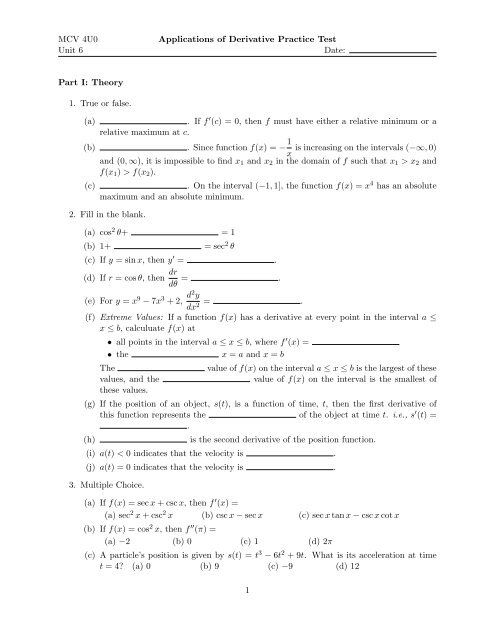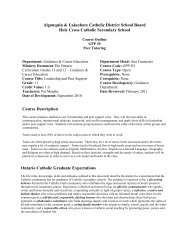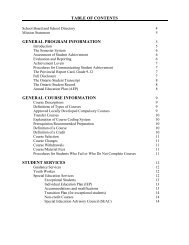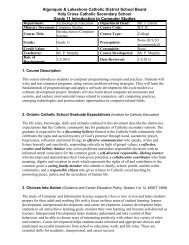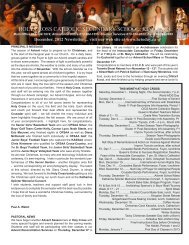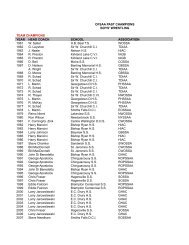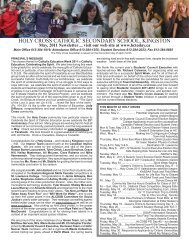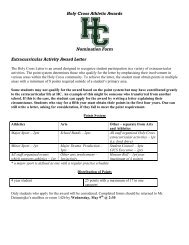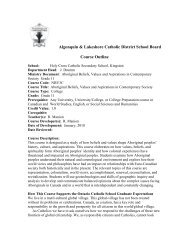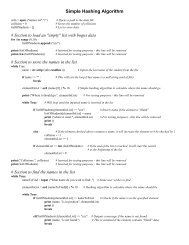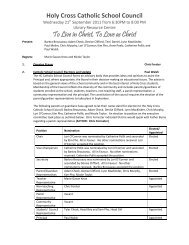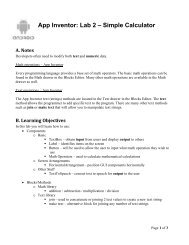Applications of Derivatives
Applications of Derivatives
Applications of Derivatives
You also want an ePaper? Increase the reach of your titles
YUMPU automatically turns print PDFs into web optimized ePapers that Google loves.
MCV 4U0<br />
Unit 6<br />
Part I: Theory<br />
1. True or false.<br />
<strong>Applications</strong> <strong>of</strong> Derivative Practice Test<br />
Date:<br />
(a) . If f ′ (c) = 0, then f must have either a relative minimum or a<br />
relative maximum at c.<br />
(b) . Since function f(x) = − 1<br />
is increasing on the intervals (−∞, 0)<br />
and (0, ∞), it is impossible to find x1 and x2 in the domain <strong>of</strong> f such that x1 > x2 and<br />
f(x1) > f(x2).<br />
(c) . On the interval (−1, 1], the function f(x) = x 4 has an absolute<br />
maximum and an absolute minimum.<br />
2. Fill in the blank.<br />
(a) cos 2 θ+ = 1<br />
(b) 1+ = sec 2 θ<br />
(c) If y = sin x, then y ′ = .<br />
(d) If r = cos θ, then dr<br />
=<br />
dθ<br />
.<br />
(e) For y = x 9 − 7x 3 + 2, d2 y<br />
= .<br />
dx2 (f) Extreme Values: If a function f(x) has a derivative at every point in the interval a ≤<br />
x ≤ b, calculuate f(x) at<br />
• all points in the interval a ≤ x ≤ b, where f ′ (x) =<br />
• the x = a and x = b<br />
The value <strong>of</strong> f(x) on the interval a ≤ x ≤ b is the largest <strong>of</strong> these<br />
values, and the value <strong>of</strong> f(x) on the interval is the smallest <strong>of</strong><br />
these values.<br />
(g) If the position <strong>of</strong> an object, s(t), is a function <strong>of</strong> time, t, then the first derivative <strong>of</strong><br />
this function represents the <strong>of</strong> the object at time t. i.e., s ′ (t) =<br />
.<br />
(h) is the second derivative <strong>of</strong> the position function.<br />
(i) a(t) < 0 indicates that the velocity is .<br />
(j) a(t) = 0 indicates that the velocity is .<br />
3. Multiple Choice.<br />
(a) If f(x) = sec x + csc x, then f ′ (x) =<br />
(a) sec 2 x + csc 2 x (b) csc x − sec x (c) sec x tan x − csc x cot x<br />
(b) If f(x) = cos 2 x, then f ′′ (π) =<br />
(a) −2 (b) 0 (c) 1 (d) 2π<br />
(c) A particle’s position is given by s(t) = t 3 − 6t 2 + 9t. What is its acceleration at time<br />
t = 4? (a) 0 (b) 9 (c) −9 (d) 12<br />
1<br />
x
MCV 4U0<br />
Unit 6<br />
<strong>Applications</strong> <strong>of</strong> Derivative Practice Test<br />
Date:<br />
(d) The maximum velocity attained on the interval 0 ≤ t ≤ 5 by the particle whose displacement<br />
is given by s(t) = 2t 3 − 12t 2 + 16t + 2 is<br />
(a) 286 (b) 46 (c) 16 (d) 0<br />
(e) If f(x) = sec(4x), then f ′ <br />
π<br />
16 is<br />
(a) 4 √ 2 (b) √ 2 (c) 0 (d) 1<br />
√ 2<br />
(f) Using the graph below, on the interval [a, b] absolute minimum value is at<br />
(a) point G (b) point H (c) point I (d) point J (e) point K<br />
y<br />
G<br />
a<br />
H<br />
I<br />
J<br />
K c<br />
(g) Using the graph from (3f), on the interval [a, b], the absolute maximum value is at<br />
(a) point G (b) point H (c) point I (d) point J (e) point K<br />
(h) Using the graph from (3f), on the interval [a, c], the absolute minimum is at<br />
(a) point G (b) point H (c) point I (d) point J (e) point K<br />
4. The critical numbers for f(x) = 3√ x − 1 are found at<br />
(a) x = −1 (b) x = 0 (c) x = 1 (d) x = {−1, 0, 1}<br />
Part II: Application<br />
1. The position <strong>of</strong> a spring is described by the function s(t) = 3 cos(2x).<br />
(a) The velocity function is v(t) = .<br />
(b) The acceleration function is a(t) = .<br />
2. Given f(x) = −2x 3 + 9x 2 + 4, find the extreme values <strong>of</strong> f(x) on [−1, 5].<br />
2<br />
b<br />
x
MCV 4U0<br />
Unit 6<br />
<strong>Applications</strong> <strong>of</strong> Derivative Practice Test<br />
Date:<br />
3. The position function <strong>of</strong> a particle is given by<br />
s(t) = √ t(3t 2 − 35t + 90)<br />
where s is measured in metres and t is in seconds.<br />
(a) Find the velocity and acceleration as a function <strong>of</strong> time.<br />
(b) Find the velocity <strong>of</strong> the particle at t = 3.<br />
(c) When is the particle at rest?<br />
(d) When is the particle moving in a positive direction.<br />
4. Mrs McCombs grows tomatoes along the side <strong>of</strong> her house. The squirrels are getting at them,<br />
and she’s decided to put a fence around the tomatoes to save them. If she has 40 m <strong>of</strong> fencing<br />
available to lay out using the straight side <strong>of</strong> her house as one line <strong>of</strong> the rectangle, what<br />
dimensions will maximize the garden area?<br />
3
MCV 4U0<br />
Unit 6<br />
<strong>Applications</strong> <strong>of</strong> Derivative Practice Test<br />
Date:<br />
5. Rick’s American Cafe sells cheeseburgers with a yearly demand function <strong>of</strong><br />
and cost function<br />
(a) State the revenue function.<br />
p =<br />
(b) Find the marginal revenue function.<br />
800000 − x<br />
200000<br />
C(x) = 125000 + 0.42x<br />
(c) What level <strong>of</strong> cheeseburger sales will maximize pr<strong>of</strong>its?<br />
6. A piece <strong>of</strong> sheet metal, 60 cm by 30 cm, is to be used to make a rectangular box with an<br />
open top. Determine the dimensions that will give the box with the largest volume.<br />
4
MCV 4U0<br />
Unit 6<br />
<strong>Applications</strong> <strong>of</strong> Derivative Practice Test<br />
Date:<br />
7. Ian and Ada are both training for a marathon. Ian’s house is located 20 km north <strong>of</strong> Ada’s<br />
house. At 9:00 am one Saturday, Ian laves his house and jogs south at 8 km/h. At the same<br />
time, Ada leaves her house and jogs east at 6 km/h. When are Ian and Ada closest together,<br />
given that they both run for 2.5 h?<br />
20<br />
J<br />
I<br />
A<br />
8. Determine the dy<br />
dx<br />
(a) y = tan x<br />
(b) y =<br />
s<br />
sin x<br />
1 + cos x<br />
B<br />
for each <strong>of</strong> the following<br />
5
MCV 4U0<br />
Unit 6<br />
(c) r = tan 3 (4θ + π)<br />
(d) y = 6 cos( √ x)<br />
<strong>Applications</strong> <strong>of</strong> Derivative Practice Test<br />
Date:<br />
9. The position <strong>of</strong> a particle as it moves horizontally is described by the function<br />
s(t) = sin 2 t − 2 cos 2 t<br />
where t ∈ [−π, π]. If s is the displacement in metres and t is the time in seconds, find the<br />
absolute maximum and minimum displacements.<br />
10. Find an equation <strong>of</strong> the tangent line to the curve y = cos2 x<br />
sin 2 x at π<br />
4 , 1 .<br />
6


